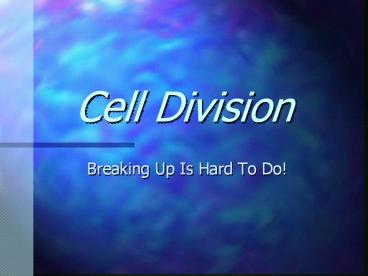Cell Division - PowerPoint PPT Presentation
1 / 35
Title:
Cell Division
Description:
Cell Division Breaking Up Is Hard To Do! Cell Division The growth and splitting of cells into two new, identical cells called daughter cells. Why Do Cells Divide? – PowerPoint PPT presentation
Number of Views:75
Avg rating:3.0/5.0
Title: Cell Division
1
Cell Division
- Breaking Up Is Hard To Do!
2
Cell Division
- The growth and splitting of cells into two new,
identical cells called daughter cells.
3
Why Do Cells Divide?
- DNA overload
- Exchanging Materials
- The volume becomes much larger than the surface
area
4
Chromosomes
- A typical human cell nucleus contains 46
chromosomes made of DNA. - You get 23 from mom and 23 from dad.
5
DNA
- When DNA is being used for daily activities it
is called chromatin. - Chromatin the relaxed fibers of DNA.
6
DNA Packing
- When it is time for mitosis, the DNA is copied
and packed for the move.
7
DNA Packing
- To pack, DNA molecules wrap around proteins
called histones and form a rod-shaped structure
called a chromosome.
8
Chromosome Structure
Section 1 Chromosomes
Chapter 8
9
Chromosome Structure
- The copied and packed DNA forms chromosomes.
- The identical halves of a chromosome are called
chromatids. - Chromatids are connected by a protein
bellybutton called a centromere.
10
A Chromosome
Chromatid
11
Chromosome
12
Chromosome Segments
- Chromosomes are divided into segments called
genes. - A small segment of DNA that codes for a protein
that results in a particular trait. - Alternate forms of a gene are called alleles.
13
Chromosome Pairs
- Chromosomes come in pairs.
- Half of the pair came from your mother, the other
from your father. - The two chromosomes when together are called
sister chromosomes or homologous chromosomes.
14
A Chromosome
Chromosome from Mother
Chromosome from Father
Sister Chromosomes
15
Karyotype
16
Cell Cycle
- Life cycle of the cell.
- Made up of the events from one mitosis to
another. - Phases are interphase, mitosis, and cytokinesis
17
Interphase
- Time for growth and development.
- Cells spend most of their time in interphase.
- The end of interphase is spent preparing for
mitosis. - G1 growth 1, doubles in size and gets large
enough to divide - S synthesis phase, copies DNA (replication)
- G2 growth 2, copies organelles and makes
proteins, enzymes that will be needed for mitosis.
18
Interphase
19
Mitosis
- Follows interphase
- Divides the genetic material (DNA) only.
- Steps involved
- Prophase
- Metaphase
- Anaphase
- Telophase
20
Reasons For Mitosis
- Multicellular Organisms
- Growth
- Repair
- Replacement of dead cells/ Maintenance
- Maturation (full grown)
- Unicellular organisms
- Asexual reproduction
21
Growth and Maintenance
- Growth an increase in size because of the
increase in the number of cells. - Maintenance replacing cells that were dead or
damaged.
22
Prophase
- Chromosomes form
- Nuclear membrane and nucleolus disappear
- Centrioles move to opposite poles
- Spindle fibers begin to form.
- Fibers made by the centrioles that pull the
chromosome copies apart during mitosis
23
Prophase
24
Prophase
25
Metaphase
- Middle phase
- The chromosomes are pushed and line up on the
equator or the center of the cell.
26
Metaphase
27
Metaphase
28
Anaphase
- Centromere holding the chromatids together
splits. - Spindle fibers shorten and pull the chromatids
apart.
29
Anaphase
30
Anaphase
31
Telophase
- Chromosomes are at opposite poles.
- Centrioles and spindle fibers disappear.
- The chromosomes begin to uncoil.
- The nuclear membrane and nucleolus reappear.
- Reverse Prophase
32
Early/ Late Telophase
33
Telophase
Early Telophase
Late Telophase
34
Cytokinesis
- Follows mitosis
- Splits the cytoplasm only.
- Results in two identical daughter cells.
- The beginning of the process is indicated by a
cleavage furrow in an animal cell and a cell
plate in a plant cell.
35
The End !































